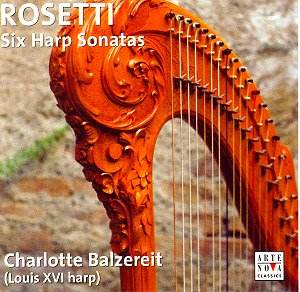Antonio Rosetti was born in the north Bohemian
town of Litomerice and initially studied to be a priest. Starting
in 1774, he became a servant and double bass player for Prince
Kraft Ernst of Oettingen-Wallerstein. Of magnanimous personality,
the Prince allowed Rosetti to travel to Paris in 1781 to further
his compositional desires. Rosetti made the most of his residence
in Paris, and his works began to be known throughout Europe. In
1789, Rosetti was given the post of Kapellmeister to the Duke
of Mecklenburg-Schwerin at the court in Ludwigslust. During this
employment, Rosetti died at the young age of 42.
Rosetti’s legacy includes 43 symphonies, over
70 concerti, and numerous chamber, keyboard and vocal pieces.
His reputation may be of obscure proportions, but there are currently
13 discs on the market devoted exclusively to his music. The CPO
label has been the champion of Rosetti’s music with 6 recordings,
but Chandos and Naxos have also advanced his cause. Although I
am not familiar with the recording, Supraphon has a disc of these
same Harp Sonatas performed by Katerina Englichova. Of course,
the Arte Nova disc is much less costly than the Supraphon.
One of the revelations that came Rosetti’s way
while in Paris was the great popularity of the harp. There was
high demand from musicians for new harp compositions, and Rosetti
was at the ready to help fill the void. However, Rosetti did not
originally intend the Sonatas on this Arte Nova disc to be for
unaccompanied harp, but for keyboard with accompanying violin.
Since the primary role for the violin in Rosetti’s Sonatas is
to double the upper line of the keyboard or harp, its absence
does not damage the structural integrity of the music.
Before moving on to the performances of the Harp
Sonatas, I should report that Rosetti did not write profound music.
Giving his works devoted concentration is not likely to be rewarding,
as they offer little that is thought-provoking or enlightening.
Whether it’s a Harp Sonata, Symphony or String Quartet, Rosetti
is best listened to while engaged in other activities.
Having said the above, the Rosetti disc at hand
presents delightful music lovingly played by Charlotte Balzereit
on a copy of a Louis XVI Harp. This single-action pedal harp has
a gorgeous tone with perfect resonance, and Balzereit gives me
the impression that she is enjoying her performances immensely.
As for the Sonatas themselves, each has three short movements
with attractive themes that are only partially developed. I think
it would be fair to say that the pieces are rather simple in conception
and do not stray far from the world of pleasant moods.
I have mixed feelings about the disc. Although
it is so easy to forget this music after playing it, I can certainly
envision its appeal in the right environment such as a candlelit
dinner with a loved one. Essentially, the pieces represents the
best that background music can offer. I also recommend the recording
to harp enthusiasts who should definitely be impressed with the
instrument played by Balzereit. Rosetti’s Harp Sonatas, although
lacking diversity and depth, could be the perfect touch to a romantic
interlude.
Don Satz
